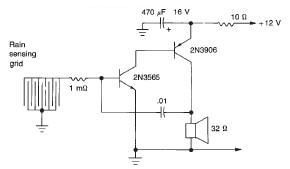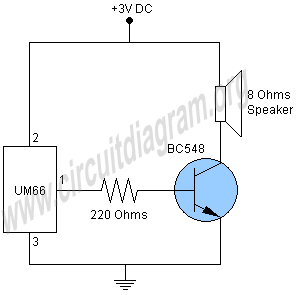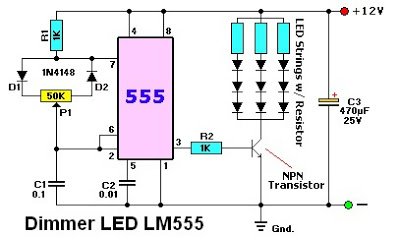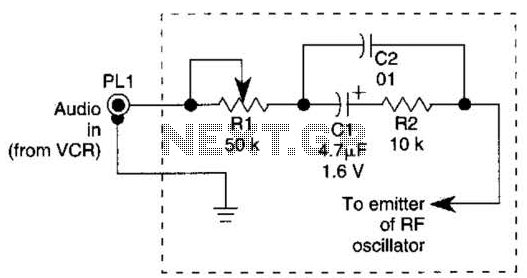
Rain detector electronic circuit project

This rain detector electronic circuit project is a simple alarm circuit that activates an audio warning when liquid is detected on the sense pad. The circuit diagram is based on two transistors. When the sense pad conducts, transistors Tr1 and Tr2 form an audio oscillatory circuit that generates a pitch sound. This circuit requires a 12-volt power supply, and the speaker should have an impedance of 32 ohms. The sense pad can be constructed on a small piece of printed circuit board.
The rain detector circuit operates by utilizing two transistors configured in a feedback loop to create an oscillator. The sense pad, which is the primary sensing element, is designed to detect the presence of liquid. It can be fabricated using conductive materials on a printed circuit board (PCB) to ensure proper sensitivity and reliability.
Upon contact with liquid, the sense pad completes the circuit, allowing current to flow through Tr1 and Tr2. This leads to the generation of an oscillating signal that drives a connected speaker, producing an audible alarm. The frequency of the oscillation can be adjusted by changing the values of the resistors and capacitors in the circuit, thereby allowing customization of the pitch of the sound emitted.
The power supply for this circuit is specified at 12 volts, which is standard for many electronic applications, ensuring compatibility with various power sources. The choice of a 32-ohm speaker is critical for achieving optimal sound output, as it matches the circuit's output characteristics and ensures efficient energy transfer.
In summary, this rain detector circuit is an effective and straightforward solution for alerting users to the presence of rain or liquid. Its design simplicity, combined with the ability to customize sound output, makes it suitable for various applications, including home automation and weather monitoring systems.This rain detector electronic circuit project is an very simple alarm circuit, that will start an audio warning, if the liquid is present on the sense pad. This rain detector electronic circuit diagram is based on two transistors. When the sense pads conducts, Tr1 and Tr2 from an audio oscillatory circuit that will generate a pitch sound.
Th is circuit needs a 12 volts power supply circuit and the speaker needs to have a 32 ohms. The sense pad can be constructed on a small piece of printed circuit board. 🔗 External reference
The rain detector circuit operates by utilizing two transistors configured in a feedback loop to create an oscillator. The sense pad, which is the primary sensing element, is designed to detect the presence of liquid. It can be fabricated using conductive materials on a printed circuit board (PCB) to ensure proper sensitivity and reliability.
Upon contact with liquid, the sense pad completes the circuit, allowing current to flow through Tr1 and Tr2. This leads to the generation of an oscillating signal that drives a connected speaker, producing an audible alarm. The frequency of the oscillation can be adjusted by changing the values of the resistors and capacitors in the circuit, thereby allowing customization of the pitch of the sound emitted.
The power supply for this circuit is specified at 12 volts, which is standard for many electronic applications, ensuring compatibility with various power sources. The choice of a 32-ohm speaker is critical for achieving optimal sound output, as it matches the circuit's output characteristics and ensures efficient energy transfer.
In summary, this rain detector circuit is an effective and straightforward solution for alerting users to the presence of rain or liquid. Its design simplicity, combined with the ability to customize sound output, makes it suitable for various applications, including home automation and weather monitoring systems.This rain detector electronic circuit project is an very simple alarm circuit, that will start an audio warning, if the liquid is present on the sense pad. This rain detector electronic circuit diagram is based on two transistors. When the sense pads conducts, Tr1 and Tr2 from an audio oscillatory circuit that will generate a pitch sound.
Th is circuit needs a 12 volts power supply circuit and the speaker needs to have a 32 ohms. The sense pad can be constructed on a small piece of printed circuit board. 🔗 External reference





